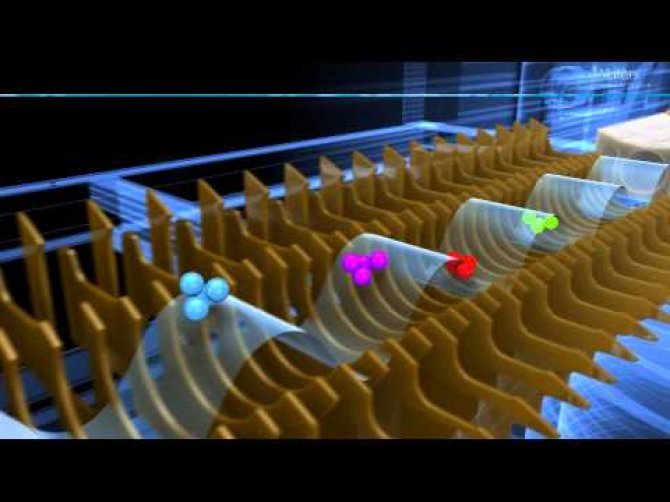
Equipment
UPLC-ESI-TWIM-MS (Synapt G2Si)
Ultra Performance Liquid Chromatography (UPLC) combined with ElectroSpray Ionization Time Of Flight Mass Spectrometry (ESI-TOF-MS) is a powerful technique to analyse and identify many different compounds like peptides, proteins, phytonutrients and carbohydrates as present in complex mixtures. With the Traveling Wave Ion Mobility (TWIM) cell the range of molecules that can be analysed is extended to the analysis of isomeric compounds, the combination with an Electron Transfer Dissociation (ETD) cell also can improve the identification of multiple charged molecules.
The mass accuracy and resolution of the Synapt G2Si are dependent of the detection mode, the high resolution mode combined with a lockmass typically will result in a mass accuracy below 1 ppm and a resolution above 50000. The mass range of the TOF is between 20 and 16000 m/z The UPLC is also equipped with photodiode array (PDA) and a Fluorescence detector (FLR) to assist identification and quantification.
Principle
Traveling Wave Ion Mobility
The separation of isomeric com¬pounds with traveling wave ion mobility is based on the rotationally-averaged collision cross section (CCS) in gas phase of the molecules. CCS is an important characteristic of a molecule and is directly related to the chemical structure and three dimensional conformation. The CCS of a molecule will influence the mobility of the molecule as it moves through a neutral gas under influence of an electric field.

Electron Transfer Dissociation
ETD is an alternative method for the standard CID fragmentation of mul¬tiple charged ions (e.g. peptides or proteins). ETD induces the fragmentation by transferring an electron from a radical anion (e.g. anthracene or 4-nitrotoluene) to the multiple charge cations. This results in c and z fragments while the side chain and modifications such as glycosylation and phosphorylation are left intact.
Technical details
Supplier Waters Corporation (Manchester, UK)
Specifications: Waters UPLC Acquity H-Class Bio- Titanium is used for the standard stainless steel parts
- Quaternary pump
- Flow rate: 0.01 – 2.00 mL/min
- Max pressure: 15000 psi (at 1 mL/min)
- Injection type: Flow through injection
- Column oven: RT – 90°C
- Sample compartment: 4 – 40°C
- Detector 1: Acquity Photodiode array (PDA)
- Wavelength range: 190 – 500 nm
- Wavelength accuracy: ± 1.0 nm
- Detector 2: Acquity Fluorescence detector (FLR)
- Wavelength range: 200 – 890 nm (excitation), 210 – 900 nm (emission), Band width: 20 nm
- Wavelength accuracy: ± 3 nm
Specifications: Waters Synapt G2Si HDMS
- Mass range: 20 – 16000 m/z
- TOF Mass resolution: 50000 FWHM (positive and negative mode)
- Mass accuracy: < 1 ppm (with Lock mass)
- Ion mobility: Triwave™ cell.
- Ion mobility resolution: ± 40
- General mass range: 20 – 32,000 Da
Applications
- ‘standard’ Proteomics
- Identification and quantification of glycopeptides/proteins
- Identification and quantification of phosphopeptides/ proteins
- Analysing intact proteins and modifications on intact proteins (up to 25 kDa)
- Profiling, identification and quantification of charged and neutral oligosaccharides
- Identification of isomeric oligosaccharides
- Identification and quantification of phytonutrients (saponins, polyphenols etc)
